Abstract
The texture and composition of river sediments are key to understanding the characteristics of source rocks, chemical weathering in the source area, physical modifications during transport, and human impacts within watersheds. This study analyzes 47 very fine to coarse size sands from the Lancang (Upper Mekong) River in China to monitor compositional variations and assesses the contribution of different geological units to trunk-river sediments. Lancang River sands are mostly feldspatho-quartzo-lithic in composition, with quartz content increasing downstream at the expense of lithic fragments (especially of carbonate lithics). Sand is mostly generated from the Lincang and Baoshan blocks, with subordinate contributions from the Simao and Changdu blocks. This study provides new insights into erosional and depositional processes in the Lancang River and emphasizes the impact of human activities on river sediment transport.
1. Introduction
River sediments can be used to trace erosion patterns across source areas and short-term to long-term watershed evolution under the impact of tectonics, climate, and human activities [,,,]. By analyzing modern river sediments, we can examine physical and chemical processes within well-constrained geological, geomorphological, and climatic settings, helping us to better understand how sediments are generated, transported, and ultimately deposited [].
The surface uplift of the Himalayan Mountains and Tibetan Plateau resulted from the continuing collision between the Indian and Asian plates [,] and initiated the formation of large Asian rivers, including the Mekong. The Lancang headwaters of the Mekong River contribute ~50% of the total sediment supplied annually to the South China Sea, amounting to 160 million tons [,]. Located in a tectonically active cold–humid climatic zone, the Lancang catchment presents excellent conditions for studying sediment provenance and recycling [,]. Previous geochronological and geochemical studies of Lancang River sediments revealed predominantly felsic source rocks exposed in the Northern Qiangtang and Yidun blocks [,], but without adequate consideration of sediment recycling and quantitative assessment of sediment contribution from different geological units.
This study analyzes the textural and compositional characteristics of river sands and their variations downstream the Lancang River in China, describes the mineralogical signatures of modern sand generated in different geological domains, and estimates sediment yield and contribution rates from different tributary catchments, distinguishing between first-cycle and recycled sediments.
2. The Lancang Basin
The Lancang River (Figure 1) originates from Mount Jifu in Zaduo County, Qinghai Province, at an elevation of 5200 m a.s.l. Within China’s territory, the mainstem is 2129 km long with a drainage area of 167,487 km2 []. In the headwaters, runoff ranges from 200 to 300 mm, gradually increasing as the river enters Yunnan Province. The Lancang River’s annual discharge has remained relatively stable through time, although with uneven distribution during the year. Flow is concentrated between May and October and minimal in January and February [].
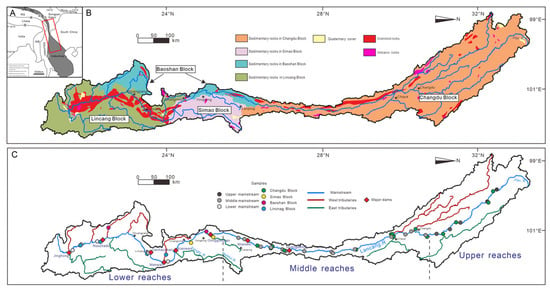
Figure 1.
The Lancang River basin (A). (B) Geological map (modified from []). (C) Drainage map. Red box is Lancang River basin’s position in tectonic framework.
The Lancang River (Figure 1C), flowing from the eastern margin of the Tibetan Plateau, runs nearly parallel to the Lancang suture zone [], a region that has remained tectonically active since the late Cenozoic []. The river drains different geological domains (Changdu, Simao, Baoshan, and Lincang blocks []; Figure 1B), and its sediments thus represent a mixture of detritus shed from various sources characterized by distinct endmember compositional signatures.
2.1. Changdu Block
The Changdu block mostly consists of Triassic sedimentary rocks. Upper Paleozoic shallow marine carbonate and clastic rocks are overlain by Lower to Middle Triassic continental to transitional volcaniclastic rocks, and in turn by Upper Triassic fluvio-deltaic clastic rocks and marine limestones. Magmatic activity took place during the Triassic [,], and the stratigraphic succession is capped by Jurassic and Cretaceous continental red beds.
2.2. Simao Block
The Simao block is dominated by Mesozoic–Cenozoic mudrocks. Older strata, exposed on both eastern and western sides, include mainly deep-water turbidites in the east, followed by Upper Permian volcaniclastic deposits in the east. Continental to shallow marine feldspar-rich sandstones, mudrocks, and carbonates are overlain by Upper Carboniferous–Lower Permian volcano-sedimentary sequences in the west [].
2.3. Baoshan Block
The Baoshan block mainly consists of Upper Paleozoic carbonates and sandstones [,,]. Cambrian–Ordovician granites dated between 502 and 444 Ma and minor volcanic rocks dated as 499–486 Ma occur; younger granites were also intruded in Upper Paleozoic to Cenozoic strata [,,,,,].
2.4. Lincang Block
The Lincang block mainly consists of quartz-schists, mica-schists, and meta-granulites in the west [,,]. Ordovician mafic-intermediate metavolcanic rocks (463–454 Ma) and granites (458.5 ± 3.0 Ma) [,,] also occur. Devonian–Carboniferous siliciclastic strata are overlain by Permian mudrocks and limestones []. The Lincang plutonic belt, bracketed between the western side of the block and the Lancang mélange belt [], mostly consists of biotite monzogranite dated as 230–200 Ma [] and locally metamorphosed to gneiss [,].
3. Methods
A total of 47 sand samples were collected from active river bars in 2021 and 2023 (24 along the mainstem at 50–100 km intervals, and 23 from major tributaries). Detailed information on sampling locations and grain-size data is provided in Table 1. Grain-size analysis was conducted using a Mastersize 2000 laser particle size analyzer at the School of Geography and Ocean Sciences, Nanjing University. Grain-size parameters were calculated following Folk and Ward []; φ values were calculated as φ = −log2D (where D is grain size in mm).

Table 1.
Sampling sites and grain-size parameters.
A quartered fraction of each sample was impregnated with Araldite epoxy and cut into a standard thin section. Petrographic analyses were carried out by counting 400–500 grains per section under the microscope according to the Gazzi–Dickinson method (inherent counting error ~5% at 1σ) []. The classification scheme for detrital components was based on the relative proportions of the three main constituents: quartz (Q), feldspar (F), and lithic fragments (L) []. Polycrystalline quartz was counted as quartz; sedimentary lithics include chert and carbonate [].
The relative sediment contributions from different tributaries and different geological units were calculated with forward mixing modeling based on petrographic data [,]. The forward mixing model computes compositional data (as row vectors, with columns representing variables) as non-negative linear combinations between a fixed endmember composition matrix (rows representing observations, columns representing variables) and coefficient row vectors representing the proportional contributions of each endmember to the observations []. We applied a filter to our data to incorporate the uncertainties of our assumptions and address the fact that natural geological complexity often diverges from theoretical models. We only used modeled compositions if the statistical distance was within 110% of the minimum value calculated using both Aitchison and Euclidean methods for each sample. Our final provenance budget and its associated uncertainties were then derived from the standard deviation of this selected set of solutions. The simulation requires first determining the endmember compositions of different tributaries and geological units, then calculating several simulated compositions by assigning different proportions of these sources [,]. To enhance simulation accuracy, multiple representative samples are typically averaged to better define the composition of endmember components.
4. Results
4.1. Texture of Lancang River Sands
The studied sand samples (7 very fine, 26 fine, 13 medium, and 1 coarse; Figure 2A,B) are mainly very fine to fine in the upper reaches, medium in the middle reaches, and very fine in the lower reaches, but with great variability and no systematic downstream fining (Figure 3). The sorting coefficient ranges from 0.5 to 3.5; only 4 samples are well sorted, 30 are poorly sorted, and 14 are very poorly sorted (Figure 2C). Skewness ranges from −0.29 to 0.72; only 2 samples show negative skewness, 2 are nearly symmetrical, 6 are positively skewed, and 37 are strongly positively skewed (Figure 2D).
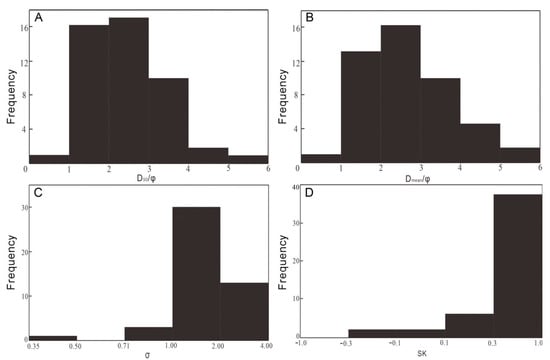
Figure 2.
Frequency distribution of grain-size parameters: (A) D50: median diameter; (B) Dmean: mean diameter; (C) σ: sorting coefficient; (D) SK: skewness.
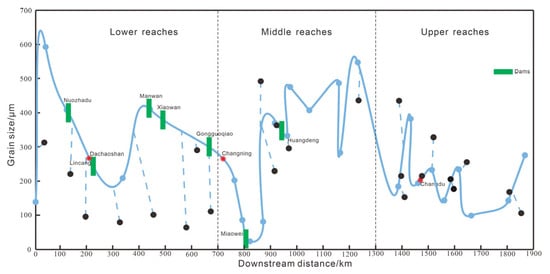
Figure 3.
Variability in mean grain size of the studied sand samples along the Lancang River. Blue dots connected by value curve are mainstream samples, and black dots are tributary samples connected with dashed lines to their respective confluence points on the main stream.
Finer samples in the upper reaches have poor sorting and positive skewness, whereas coarser samples in the middle reaches have extremely positive skewness. Textural variability appears to be influenced by human impacts (e.g., hydropower stations, riverside road development, steep slope cultivations [,,,,]). Natural downstream fining and selective transport make minor contributions to the grain size distribution. Eight major dams (Huangdeng, Miaowei, Gongguoqiao, Xiaowan, Manwan, Dachaoshan, Nuozhadu, and Jinghong) were built in the middle and lower reaches (Figure 1C). The proximity of reservoir locations to the site of coarser-grain samples with extremely positive skewness suggests that cascade dams induce sediment coarsening. Because river bedload is efficiently trapped in artificial reservoirs, the enhanced erosion power of clear water downstream of dams leads to erosion and resuspension of older channel and bank deposits [,,], explaining the coarser size and extremely positive skewness of samples collected shortly downstream of dams.
4.2. Petrography of Lancang River Sands
Lancang River sands are mostly feldspatho-quartzo-lithic (Figure 4). Quartz is mainly monocrystalline, feldspars are mostly potassic, and rock fragments are predominantly sedimentary with only minor volcanic and metamorphic types (Figure 5 and Table 2).
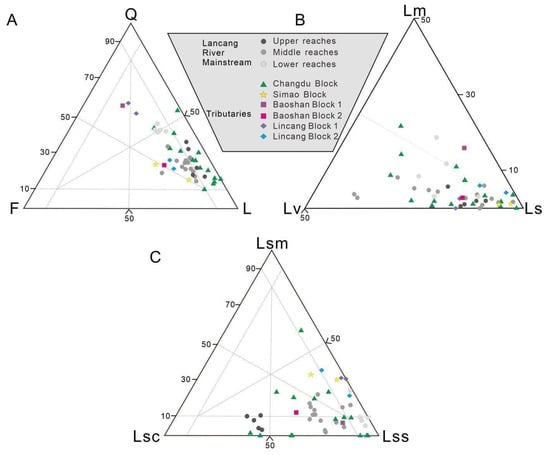
Figure 4.
Sandstone petrography. (A) Q: quartz, F: feldspar, L: lithic plot (compositional fields after [,]); (B) Lm: metamorphic, Lv: volcanic, Ls: sedimentary lithic plot; (C) Lss: shale, Lsc: carbonate; Lss: sand(silt)stone lithic plot.
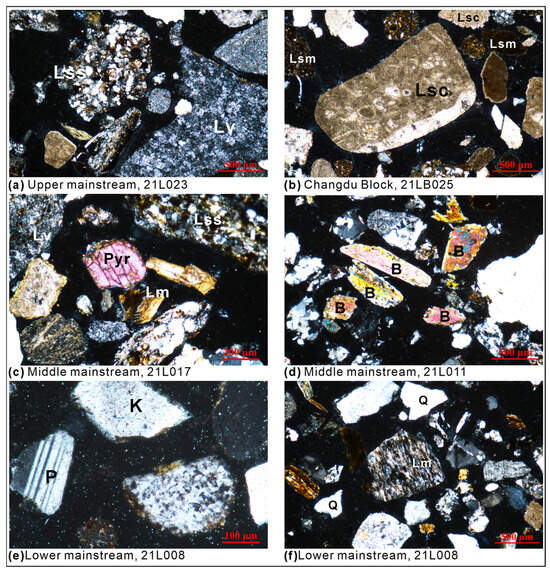
Figure 5.
Petrography of Lancang River sands. Q: quartz, K: K-feldspar, P: plagioclase; L: lithics (Lv: volcanic, Lm: metamorphic, Lss: siltstone, Lsc: carbonate, Lsm: shale), B: biotite, Pyr: pyroxene.

Table 2.
Petrographic composition of Lancang River sand (grain counts).
The Lancang mainstem is here divided into upper reaches of Changdu (5 samples), middle reaches upstream of Gongguoqiao Dam (14 samples), and lower reaches downstream (5 samples). In the upper reaches, samples are quartzo-lithic and feldspatho-quartzo-lithic (average composition Q25F10L65, Ls88Lv10Lm2, Lsm10Lsc39Lss51). In the middle reaches, samples are mainly feldspatho-quartzo-lithic and subordinately quartzo-feldspatho-lithic and quartzo-lithic (average composition Q23F13L64, Ls78Lv18Lm4, Lsm10Lsc20Lss70). In the lower reaches, samples are feldspatho-litho-quartzose and feldspatho-quartzo-lithic (average composition Q43F15L42, Ls79Lv13Lm8, Lsm11Lsc2Lss87). Carbonate grains thus markedly decrease downstream, whereas quartz, feldspar, and siltstone rock fragments relatively increase.
Tributary samples are classified into four groups (Changdu, Simao, Baoshan 1 and 2, Lincang 1 and 2). The 15 tributaries draining the Changdu block (Changdu group) carry mainly quartzo-lithic and subordinately litho-quartzose, feldspatho-litho-quartzose, and feldspatho-quartzo-lithic sand (average composition Q26F7L67, Ls82Lv13Lm5, Lsm12Lsc23Lss65). The two tributaries draining the Lanping–Simao Basin (Simao group) carry feldspatho-quartzo-lithic and quartzo-feldspatho-lithic sand (average composition Q19F21L60, Ls95Lv4Lm1, Lsm31Lsc10Lss59). The two tributaries draining the Baoshan block carry litho-feldspatho-quartzose (Q56F26L18, Ls79Lv7Lm14, Lsm6Lsc13Lss81; Baoshan 1 tributary) or feldspatho-quartzo-lithic sand (Q23F23L54, Ls85Lv13Lm2, Lsm12Lsc32Lss56; Baoshan 2 tributary). Tributaries draining the Lincang block carry litho-feldspatho-quartzose (average composition Q54F21L25, Ls84Lv14Lm2, Lsm31Lsc1Lss68; Lincang 1 tributaries mainly draining the Lincang plutonic belt) or feldspatho-litho-quartzose sand (average composition Q24F19L57, Ls91Lv4Lm5, Lsm28Lsc6Lss66; Lincang 2 tributary).
Quartz is prevalent and siltstone lithics least abundant in Baoshan 1 and Lincang 1 tributaries, feldspar least abundant in Changdu tributaries, and volcanic and carbonate grains more common in Changdu and Baoshan 2 tributaries. Compositional variability along the Lancang mainstem is illustrated in Figure 6.
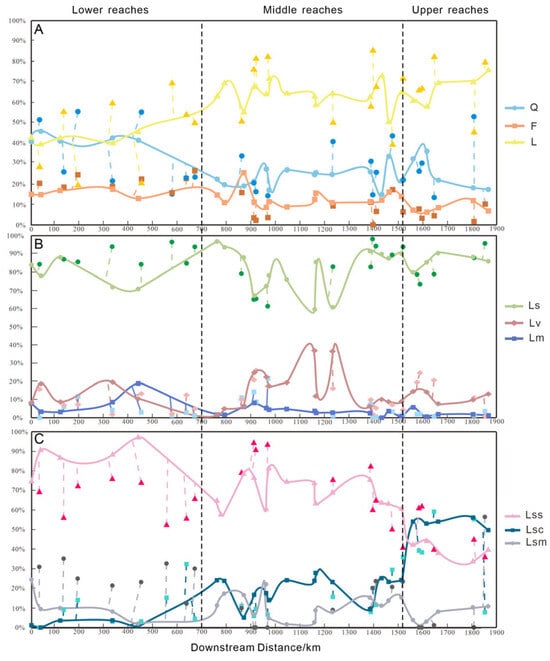
Figure 6.
Compositional variability along the Lancang mainstem. (A) QFL percentages, (B) lithic fragments percentages, (C) sedimentary rock fragments percentages. Q: quartz, F: feldspar, L: lithics (Lm: metamorphic, Lv: volcanic, Ls: sedimentary; Lss: shale, Lsc: carbonate, Lss: siltstone). Mainstem samples are connected with a smooth curve, tributary samples with dashed lines to their respective confluences with the mainstem.
5. Discussion
5.1. Provenance Budget Based on Petrographic Data
Forward mixing calculations indicate that final Lancang sand upstream of the China border originates mainly from the Lincang block (52 ± 20%; 6 ± 6% for Lincang 1 and 46 ± 15% for Lincang 2), subordinately from the Baoshan block (32 ± 9%; 2 ± 2% for Baoshan1 and 30 ± 9% for Baoshan 2), and in minor part from the Changdu and Simao blocks (8 ± 7% each) (Figure 7).
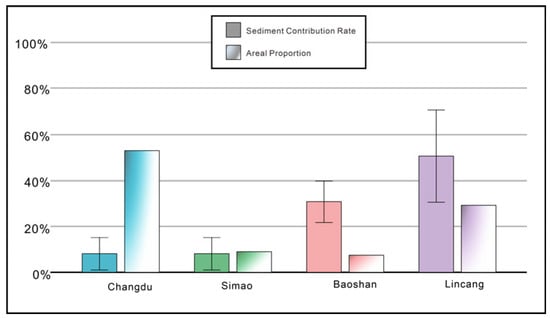
Figure 7.
Sediment yields from different geological units in the Lancang catchment.
Sand is calculated to be overwhelmingly (92 ± 8%) recycled from sedimentary rocks drained by Changdu, Simao, Baoshan 2, and Lincang 2 tributaries, whereas first-cycle contribution from granitic sources drained by Lincang1 and Baoshan 1 tributaries is assessed to be only 8 ± 8%. Taking into account the basin areas occupied by the Changdu (85,335 km2, 53% of total area), Simao (15,660 km2, 10%), Baoshan (13,546 km2, 8%), and Lincang blocks (45,549 km2, 28%), the highest sediment yields are assessed for the Baoshan and Lincang blocks (Figure 7). Sediment supply results are higher for tributaries in the upper reaches than for tributaries in the middle reaches, rising again for tributaries in the lower reaches (Figure 7).
Our estimates differ from previous indications based on U-Pb zircon dating and geochemical research, suggesting that Lancang River sand mainly originates from the Northern Qiangtang block [,]. To check for this discrepancy, we analyzed the available hydrological data from five gauging stations (data shown in Supplementary Materials Table S1). The recorded average annual discharges and sediment loads are 30.0 km3 and 22.7 × 106 t for the Gongguoqiao station, 37.1 km3 and 42.5 × 106 t for the Gajiu station, 28.2 km3 and 22.7 × 106 t for the Jiuzhou station, 22.8 km3 and 22.7 × 106 t for the Liutongjiang station, and 56.8 km3 and 82.5 × 106 t for the Yunxianghong station. Based on these data, 22.7 × 106 t, 0.004 × 106 t, 19.2 × 106 t, and 40.1 × 106 t of sediment are produced in the four river tracts delimited by dams, with corresponding annual sediment yields of 295 t/km2, 0.2 t/km2, 1097 t/km2, and 1173 t/km2 (Figure 8). The resulting higher sediment yields from the lower reaches are consistent with the outcome of forward mixing calculations.
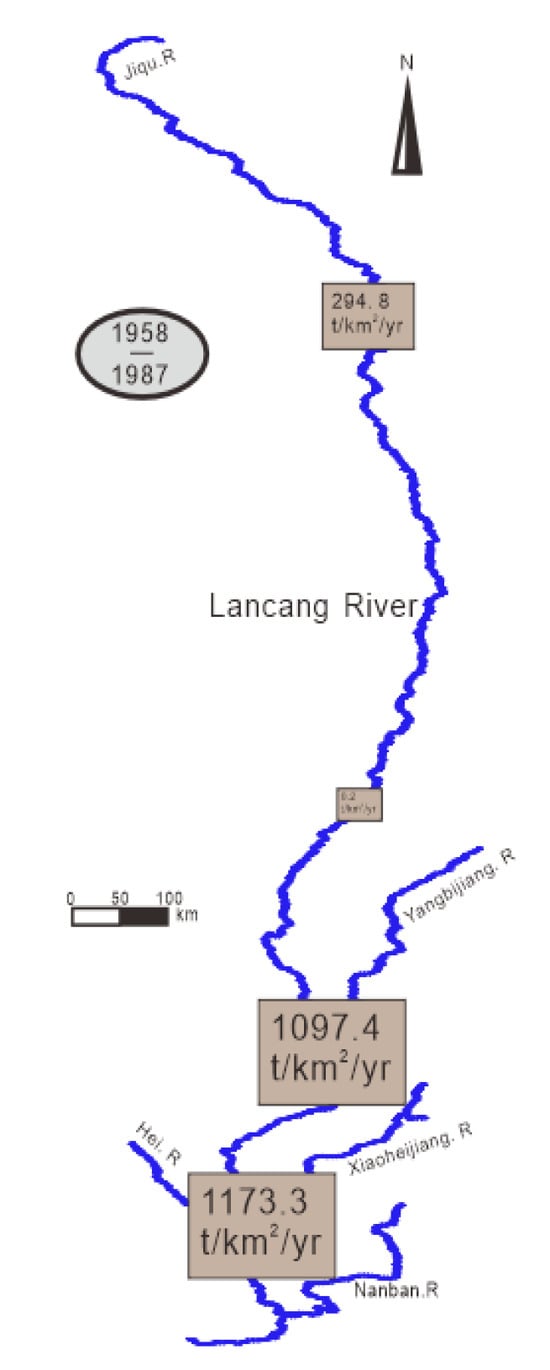
Figure 8.
Sediment yield in four tracts of the Lancang catchment based on hydrological data (data from hydrological yearbook of Sanjiang catchment from 1958 to 1987 (Table S1)). River course in blue.
5.2. First-Cycle Versus Recycled River Sand
Sedimentary rocks are the primary source of Lancang River sediments. This is testified by the abundance of shale, siltstone, sandstone, and carbonate rock fragments in most samples (e.g., 21LB006, 21LB012, and 21LB013), whereas only a few (e.g., 21LB011, 21LB014, and 21LB015) contain a significant amount of first-cycle detritus, including minor igneous and metamorphic rock fragments and more biotite and heavy minerals. Most Lancang River sand is thus recycled. Regarding optical characteristics, first-cycle samples exhibit quartz and feldspar grains with clear boundaries and smooth surfaces. In recycled samples, quartz grains are instead commonly well-rounded and show turbid surfaces and concave outlines, and feldspars appear notably altered. All samples are, however, mixed, largely first-cycle samples also containing some sedimentary rock fragments and largely recycled samples including volcanic or plutonic grains as well as hornblende, pyroxene, and epidote.
5.3. Durability of Carbonate Grains
Carbonate rock fragments (mostly sparry to bioclastic limestone) are most abundant in the upper reaches (Figure 4), where they represent 50–60% of sedimentary rock fragments (Figure 6C). This proportion decreases to 10–30% in the middle reaches, where carbonate particles are mostly micritic limestone with minor sparite locally containing quartz-rich silt, and becomes very low in the lower reaches, where mainly micritic lithics occur. Such a downstream decrease in carbonate grains primarily reflects provenance, carbonate rocks being mostly extensively exposed in the Changdu block. The presence of large reservoirs prevents the transportation of these grains downstream, where carbonate exposures are sparse. However, cathodoluminescence analysis could help distinguish different types of carbonate fragments and assess their degree of abrasion and roundness, providing valuable insights into source lithologies and transport pathways [,].
In large rivers draining humid regions and characterized by high discharge and waters with high pCO2 levels, such as the Brahmaputra, the Congo, or the Pearl River, carbonate grains may be efficiently dissolved [,,,,,]. Selective mechanical breakdown of carbonate grains may also occur (Figure 4 in []). These effects are, however, difficult to separate from the effect of downstream dilution by carbonate-poor tributary sands, enhanced in highly man-regulated river systems by efficient sediment sequestration in reservoirs upstream. The natural controls of compositional change between different downstream tracts of the heavily dam-segmented course of the Lancang River are consequently hard to evaluate.
6. Conclusions
Sands carried by the Lancang (Upper Mekong) River are mainly feldspatho-quartzo-lithic with dominant sedimentary rock fragments. Quartz content increases downstream at the expense of lithic fragments. Carbonate rock fragments decrease markedly, whereas siltstone/sandstone fragments relatively increase. Sand is thus mostly recycled from sedimentary rocks, with minor contributions from igneous rocks. Based on forward modeling calculations, sand is mostly derived from the Lancang (52 ± 20%) and Baoshan blocks (32 ± 9%), with minor contributions from the Simao and Changdu blocks (~8% each).
Most textural and compositional variability along the Lancang River was mainly induced by anthropogenic impact. Eight major dams were built in the middle and lower reaches, leading to extreme segmentation of sediment fluxes and thus preventing us from separately identifying and evaluating the effect of natural processes, such as the potential selective chemical or physical breakdown of more labile grains, including carbonate and shale rock fragments. To evaluate erosion rates, we thus resorted to the analysis of the available hydrological data from five gauging stations, which allowed us to constrain provenance budgets and calculate annual sediment yields increasing from ~300 t/km2 in the upper reaches to >1000 t/km2 in the lower reaches.
Supplementary Materials
The following supporting information can be downloaded at https://www.mdpi.com/article/10.3390/geosciences15110415/s1, Table S1: Multiyear flow table and annual sediment transport.
Author Contributions
Conceptualization, X.H.; methodology, X.H. and E.G.; validation, D.F., X.H., and W.L.; formal analysis, D.F., X.H., W.L., and F.C.; investigation, D.F., X.H. and F.C.; resources, X.H. and D.F.; data curation, D.F., X.H., E.G., and F.C.; writing—original draft, D.F., X.H., and E.G.; writing—review and editing, E.G.; visualization, X.H. and D.F.; supervision, X.H.; project administration, X.H. All authors have read and agreed to the published version of the manuscript.
Funding
This research was financially supported by the Second Tibetan Plateau Scientific Expedition Research Program (STEP, Grant No. 2019QZKK020402) and GeoX’ Interdisciplinary Project of Frontiers Science Center for Critical Earth Material Cycling, Grant No. 20250102.
Data Availability Statement
The original contributions presented in this study are included in the article/Supplementary Materials. Further inquiries can be directed to the corresponding authors.
Acknowledgments
The authors are grateful to Wendong Liang, Xiaolong Dong, and Keran Li for their assistance with sample collection and express their sincere gratitude to the editors and the anonymous reviewers for their valuable comments and suggestions.
Conflicts of Interest
The authors declare no conflicts of interest.
Glossary
| Block | Tectono-stratigraphic terranes accreted to an orogenic belt and characterized by a unique assemblage of lithologies, stratigraphic succession, and tectonic evolution. |
| First-cycle sediment | Sediment typically enriched in feldspars, volcanic and/or metamorphic rock fragments, and heavy minerals derived directly from igneous rocks and/or metamorphic basement. |
| Recycled sediment | Sediment typically enriched in durable minerals (quartz, zircon, tourmaline, rutile) derived from the erosion of pre-existing lithified sedimentary rocks or loose siliciclastic deposits. |
References
- Burbank, D.W.; Blythe, A.E.; Putkonen, J.; Pratt-Sitaula, B.; Gabet, E.; Oskin, M.; Barros, A.; Ojha, T.P. Decoupling of erosion and precipitation in the Himalayas. Nature 2003, 426, 652–655. [Google Scholar] [CrossRef] [PubMed]
- Godard, V.; Bourlès, D.L.; Spinabella, F.; Burbank, D.W.; Bookhagen, B.; Fisher, G.B.; Moulin, A.; Léanni, L. Dominance of tectonics over climate in Himalayan denudation. Geology 2014, 42, 243–246. [Google Scholar] [CrossRef]
- Wang, P.; Scherler, D.; Liu-Zeng, J.; Mey, J.; Avouac, J.-P.; Zhang, Y.; Shi, D. Tectonic control of Yarlung Tsangpo Gorge revealed by a buried canyon in Southern Tibet. Science 2014, 346, 978–981. [Google Scholar] [CrossRef] [PubMed]
- Sickmann, Z.T.; Chheda, T.D.; Capaldi, T.N.; Thomson, K.D.; Paull, C.K.; Graham, S.A. Using provenance analysis in an Anthropocene natural laboratory. Quat. Sci. Rev. 2019, 221, 105890. [Google Scholar] [CrossRef]
- Liang, W.; Hu, X. Research progress of sand composition in river sediments. Acta Geol. Sin. 2023, 97, 2975–2991. [Google Scholar] [CrossRef]
- Harris, N. The elevation history of the Tibetan Plateau and its implications for the Asian monsoon. Palaeogeogr. Palaeoclimatol. Palaeoecol. 2006, 241, 4–15. [Google Scholar] [CrossRef]
- Kapp, P.; Murphy, M.A.; Yin, A.; Harrison, T.M.; Ding, L.; Guo, J. Mesozoic and Cenozoic tectonic evolution of the Shiquanhe area of western Tibet. Tectonics 2003, 22, 1029. [Google Scholar] [CrossRef]
- Walling, D.E. Chapter 6—The Sediment Load of the Mekong River. In The Mekong; Campbell, I.C., Ed.; Academic Press: Cambridge, MA, USA, 2009; pp. 113–142. [Google Scholar] [CrossRef]
- Zhang, J.; Yang, H.; Liu-Zeng, J.; Ge, Y.; Wang, W.; Yao, W.; Xu, S. Reconstructing the incision of the Lancang River (Upper Mekong) in southeastern Tibet below its prominent knickzone using fluvial terraces and transient tributary profiles. Geomorphology 2021, 376, 107551. [Google Scholar] [CrossRef]
- Liu, Z.; Colin, C.; Trentesaux, A.; Siani, G.; Frank, N.; Blamart, D.; Farid, S. Late Quaternary climatic control on erosion and weathering in the eastern Tibetan Plateau and the Mekong Basin. Quat. Res. 2005, 63, 316–328. [Google Scholar] [CrossRef]
- Zhang, P.; Najman, Y.; Mei, L.; Millar, I.; Sobel, E.R.; Carter, A.; Barfod, D.; Dhuime, B.; Garzanti, E.; Govin, G.; et al. Palaeodrainage evolution of the large rivers of East Asia, and Himalayan-Tibet tectonics. Earth-Sci. Rev. 2019, 192, 601–630. [Google Scholar] [CrossRef]
- Chen, X.; Chen, Y.; Bao, C.; Li, G.; Yan, J.; Li, D. U-Pb dating and Hf isotopic composition of detrital zircons in the sediments from the Lancang River and its geological significance. Geoscience 2014, 28, 1170–1182. [Google Scholar]
- Huyan, Y.; Zhang, B.; Wang, X.; Lu, Y.; Liu, F. Geochemistry of the Lancang River (Upper Mekong River) overbank sediments: Implications for provenance, weathering and sedimentary characteristics. Appl. Geochem. 2023, 156, 105747. [Google Scholar] [CrossRef]
- Chen, Q.; Kong, X. Lancang-Mekong River Basin Basic Data Collections; Yunnan Science and Technical Press: Kunming, China, 2000; pp. 1–259. [Google Scholar]
- Li, L.; Li, H.; Wang, J. Analysis on hydrological and water quality character and their spatial and temporal distribution in Lancang River. Sci. Geogr. Sin. 2002, 22, 49–56. [Google Scholar]
- Zhang, P.Z.; Shen, Z.; Wang, M.; Gan, W.; Bürgmann, R.; Molnar, P.; Wang, Q.; Niu, Z.; Sun, J.; Wu, J.; et al. Continuous deformation of the Tibetan Plateau from global positioning system data. Geology 2004, 32, 809–812. [Google Scholar] [CrossRef]
- Deng, J.; Wang, Q.; Li, G.; Santosh, M. Cenozoic tectono-magmatic and metallogenic processes in the Sanjiang region, southwestern China. Earth-Sci. Rev. 2014, 138, 268–299. [Google Scholar] [CrossRef]
- Liu, Z.; Colin, C.; Huang, W.; Le, K.P.; Tong, S.; Chen, Z.; Trentesaux, A. Climatic and tectonic controls on weathering in south China and Indochina Peninsula: Clay mineralogical and geochemical investigations from the Pearl, Red, and Mekong drainage basins. Geochem. Geophys. Geosyst. 2007, 8, Q05005. [Google Scholar] [CrossRef]
- Xia, D. Lithostratigraphy of Xizang Autonomous Region; China University of Geosciences Press: Wuhan, China, 1997; pp. 1–302. [Google Scholar]
- Wang, L. Geological Map and Instruction Manual of the Qinghai Tibet Plateau and Its Adjacent Areas; Geology Press: Beijing, China, 2013; pp. 1–155. [Google Scholar]
- Zhong, D. The Paleo-Tethys Orogenic Belt in Western Sichuan and Yunnan Province; Science Press: Beijing, China, 1998; pp. 1–242. [Google Scholar]
- Metcalfe, I. Gondwana dispersion and Asian accretion: Tectonic and palaeogeographic evolution of eastern Tethys. J. Asian Earth Sci. 2013, 66, 1–33. [Google Scholar] [CrossRef]
- Metcalfe, I. Multiple Tethyan ocean basins and orogenic belts in Asia. Gondwana Res. 2021, 100, 87–130. [Google Scholar] [CrossRef]
- Lin, Y.; Wei, G.; Zengtao, C.; Yulong, Y.; Yan, T. LA-ICP-MS Zircon U-Pb Geochronology and Petrology of the Muchang Alkali Granite, Zhenkang County, Western Yunnan Province, China. Acta Geol. Sin. Engl. Ed. 2010, 84, 1488–1499. [Google Scholar] [CrossRef]
- Dong, M.; Dong, G.; Mo, X.; Santosh, M.; Zhu, D.; Yu, J.; Nie, F.; Hu, Z. Geochemistry, zircon U–Pb geochronology and Hf isotopes of granites in the Baoshan Block, Western Yunnan: Implications for Early Paleozoic evolution along the Gondwana margin. Lithos 2013, 179, 36–47. [Google Scholar] [CrossRef]
- Li, D.; Chen, Y.; Hou, K.; Luo, Z. Origin and evolution of the Tengchong block, southeastern margin of the Tibetan Plateau: Zircon U–Pb and Lu–Hf isotopic evidence from the (meta-) sedimentary rocks and intrusions. Tectonophysics 2016, 687, 245–256. [Google Scholar] [CrossRef]
- Zhu, R.; Lai, S.; Qin, J.; Zhao, S.; Santosh, M. Strongly peraluminous fractionated S-type granites in the Baoshan Block, SW China: Implications for two-stage melting of fertile continental materials following the closure of Bangong-Nujiang Tethys. Lithos 2018, 316–317, 178–198. [Google Scholar] [CrossRef]
- Huan, Y.; Li, X.; Lei, H. Zircon U-Pb age and geochemical characteristics of the early palaeozoic granite in Shiganhe-Pinghe area, west Yunnan. Miner. Resour. Geol. 2017, 31, 150–157. [Google Scholar]
- Tao, Y.; Zhu, F.; Ma, Y.; Ye, L.; Cheng, Z. La-ICP-MS analysis of granite in Benzhishan aera, Baoshan Block. Acta Mineral. Sin. 2009, 29, 329. [Google Scholar]
- Liu, B.; Peng, T.; Fan, W.; Zhao, G.; Gao, J.; Dong, X.; Peng, B. Tectonic Evolution and Paleoposition of the Baoshan and Lincang Blocks of West Yunnan During the Paleozoic. Tectonics 2020, 39, e2019TC006028. [Google Scholar] [CrossRef]
- Liu, G. Petrology Component and Geochronology of Early Paleozoic Proto-Tethys Ophiolite Mélange in SW Yunnan. Ph.D. Thesis, China University of Geosciences, Wuhan, China, 2020; pp. 1–153. [Google Scholar]
- Zhao, T.Y. Early Paleozoic Proto-Tethys Tectonics Evolution in SW Yunnan: Constraints from Detrital Zircon U-Pb Geochronology and Granite Associations. Ph.D. Thesis, China University of Geosciences, Wuhan, China, 2019; pp. 1–133. [Google Scholar]
- Nie, X.; Feng, Q.; Qian, X.; Wang, Y. Magmatic Record of Prototethyan Evolution in SW Yunnan, China: Geochemical, Zircon U–Pb Geochronological and Lu–Hf Isotopic Evidence from the Huimin Metavolcanic Rocks in the Southern Lancangjiang Zone. Gondwana Res. 2015, 28, 757–768. [Google Scholar] [CrossRef]
- Xing, X.; Wang, Y.; Cawood, P.A.; Zhang, Y. Early Paleozoic accretionary orogenesis along northern margin of Gondwana constrained by high-Mg metaigneous rocks, SW Yunnan. Int. J. Earth Sci. 2017, 106, 1469–1486. [Google Scholar] [CrossRef]
- Zhao, T.; Feng, Q.; Metcalfe, I.; Milan, L.A.; Liu, G.; Zhang, Z. Detrital zircon U-Pb-Hf isotopes and provenance of Late Neoproterozoic and Early Paleozoic sediments of the Simao and Baoshan blocks, SW China: Implications for Proto-Tethys and Paleo-Tethys evolution and Gondwana reconstruction. Gondwana Res. 2017, 51, 193–208. [Google Scholar] [CrossRef]
- Dong, G.; Mo, X.; Zhao, Z.; Zhu, D.; Goodman, R.C.; Kong, H.; Wang, S. Zircon U–Pb dating and the petrological and geochemical constraints on Lincang granite in Western Yunnan, China: Implications for the closure of the Paleo-Tethys Ocean. J. Asian Earth Sci. 2013, 62, 282–294. [Google Scholar] [CrossRef]
- Luo, B. Petrology Geochemistry, Chronology Characteristics and Their Significances of Early Paleozoic Granite in Yunxian, West Yunnan. Master’s Thesis, Chengdu University of Technology, Chengdu, China, 2020; pp. 1–60. [Google Scholar]
- Peng, Z.; Zhang, J.; Guan, J.; Zhang, Z.; Han, W.; Fu, Y. The discovery of early-midde ordovician granitic gneiss from the giant Lincang batholith in Sangjiang area of western Yunnan and its geological implications. Earth Sci. 2018, 43, 2571–2585. [Google Scholar]
- Ingersoll, R.V.; Bullard, T.F.; Ford, R.L.; Grimm, J.P.; Pickle, J.D.; Sares, S.W. The effect of grain size on detrital modes: A test of the Gazzi-Dickinson point-counting method. J. Sediment. Res. 1984, 54, 103–116. [Google Scholar] [CrossRef]
- Folk, R.L.; Ward, W.C. Brazos River bar [Texas]; A study in the significance of grain size parameters. J. Sediment. Res. 1957, 27, 3–26. [Google Scholar] [CrossRef]
- Garzanti, E. From static to dynamic provenance analysis—Sedimentary petrology upgraded. Sediment. Geol. 2016, 336, 3–13. [Google Scholar] [CrossRef]
- Garzanti, E. Petrographic classification of sand and sandstone. Earth-Sci. Rev. 2019, 192, 545–563. [Google Scholar] [CrossRef]
- Weltje, G.J. End-member modeling of compositional data: Numerical-statistical algorithms for solving the explicit mixing problem. Math. Geol. 1997, 29, 503–549. [Google Scholar] [CrossRef]
- Resentini, A.; Goren, L.; Castelltort, S.; Garzanti, E. Partitioning sediment flux by provenance and tracing erosion patterns in Taiwan. J. Geophys. Res. Earth Surf. 2017, 122, 1430–1454. [Google Scholar] [CrossRef]
- Liang, W.; Garzanti, E.; Hu, X.; Resentini, A.; Vezzoli, G.; Yao, W. Tracing erosion patterns in South Tibet: Balancing sediment supply to the Yarlung Tsangpo from the Himalaya versus Lhasa Block. Basin Res. 2022, 34, 411–439. [Google Scholar] [CrossRef]
- Fu, K.; Yang, W.; Su, B.; Li, D.; Li, M.; Zhang, J.; Song, J. Response of river sediments to basin environmental changes: A case study of the Lancang River. Prog. Geogr. 2015, 34, 1148–1155. [Google Scholar]
- Mo, B. Application of Particle Size Analysis in Sedimentary Characteristics: A case study of quaternart sediments from Zhujiang delta. Nei Jiang Ke Ji 2018, 39, 24–25. [Google Scholar]
- Syvitski, J.P.M.; Vörösmarty, C.J.; Kettner, A.J.; Green, P. Impact of Humans on the Flux of Terrestrial Sediment to the Global Coastal Ocean. Science 2005, 308, 376–380. [Google Scholar] [CrossRef]
- Dai, S.; Yang, S.; Li, M. The sharp decrease in suspended sediment supply from China’s rivers to the sea: Anthropogenic and natural causes. Hydrol. Sci. J. 2009, 54, 135–146. [Google Scholar] [CrossRef]
- Wang, H.; Sun, F. Variability of annual sediment load and runoff in the Yellow River for the last 100 years (1919–2018). Sci. Total Environ. 2021, 758, 143715. [Google Scholar] [CrossRef] [PubMed]
- Grant, G.E. The Geomorphic Response of Gravel-Bed Rivers to Dams: Perspectives and Prospects. In Gravel-Bed Rivers; John Wiley & Sons, Inc.: Hoboken, NJ, USA, 2012; pp. 165–181. [Google Scholar] [CrossRef]
- Topping, D.J.; Rubin, D.M.; Melis, T.S. Coupled changes in sand grain size and sand transport driven by changes in the upstream supply of sand in the Colorado River: Relative importance of changes in bed-sand grain size and bed-sand area. Sediment. Geol. 2007, 202, 538–561. [Google Scholar] [CrossRef]
- Guo, X.; Zhu, X.; Yang, Z.; Ma, J.; Xiao, S.; Ji, D.; Liu, D. Impacts of cascade reservoirs on the longitudinal variability of fine sediment characteristics: A case study of the Lancang and Nu Rivers. J. Hydrol. 2020, 581, 124343. [Google Scholar] [CrossRef]
- Pszonka, J.; Wendorff, M. Cathodoluminescence-revealed diagenesis of carbonates and feldspars in Cergowa sandstones (Oligocene), Outer Carpathians. Gospod. Surowcami Miner. 2014, 30, 21–36. [Google Scholar]
- Pszonka, J.; Wendorff, M. Carbonate cements and grains in submarine fan sandstones—The Cergowa Beds (Oligocene, Carpathians of Poland) recorded by cathodoluminescence. Int. J. Earth Sci. 2017, 106, 269–282. [Google Scholar] [CrossRef]
- Singh, S.K.; France-Lanord, C. Tracing the distribution of erosion in the Brahmaputra watershed from isotopic compositions of stream sediments. Earth Planet. Sci. Lett. 2002, 202, 645–662. [Google Scholar]
- Garzanti, E.; Vermeesch, P.; Vezzoli, G.; And‘o, S.; Botti, E.; Limonta, M.; Dinis, P.; Hahn, A.; Baudet, D.; De Grave, J.; et al. Congo River sand and the equatorial quartz factory. Earth-Sci. Rev. 2019, 197, 102918. [Google Scholar] [CrossRef]
- Garzanti, E.; He, J.; Barbarano, M.; Resentini, A.; Li, C.; Yang, L.; Yang, S.; Wang, H. Provenance versus weathering control on sediment composition in tropical monsoonal climate (South China)-2. Sand petrology and heavy minerals. Chem. Geol. 2021, 564, 119997. [Google Scholar]
- Garzanti, E. The maturity myth in sedimentology and provenance analysis. J. Sediment. Res. 2017, 87, 353–365. [Google Scholar] [CrossRef]
- Xu, Y.; Jin, Z.; Gou, L.F.; Galy, A.; Jin, C.; Chen, C.; Li, C.; Deng, L. Carbonate weathering dominates magnesium isotopes in large rivers: Clues from the Yangtze River. Chem. Geol. 2022, 588, 120677. [Google Scholar] [CrossRef]
- Li, C.; Wang, S.; Bai, X.; Tan, Q.; Li, H.; Li, Q.; Deng, Y.; Yang, Y.; Tian, S.; Hu, Y. Estimation of carbonate rock weathering-related carbon sink in global major river basins. Acta Geogr. Sin. 2019, 74, 1319–1332. [Google Scholar]
Disclaimer/Publisher’s Note: The statements, opinions and data contained in all publications are solely those of the individual author(s) and contributor(s) and not of MDPI and/or the editor(s). MDPI and/or the editor(s) disclaim responsibility for any injury to people or property resulting from any ideas, methods, instructions or products referred to in the content. |
© 2025 by the authors. Licensee MDPI, Basel, Switzerland. This article is an open access article distributed under the terms and conditions of the Creative Commons Attribution (CC BY) license (https://creativecommons.org/licenses/by/4.0/).